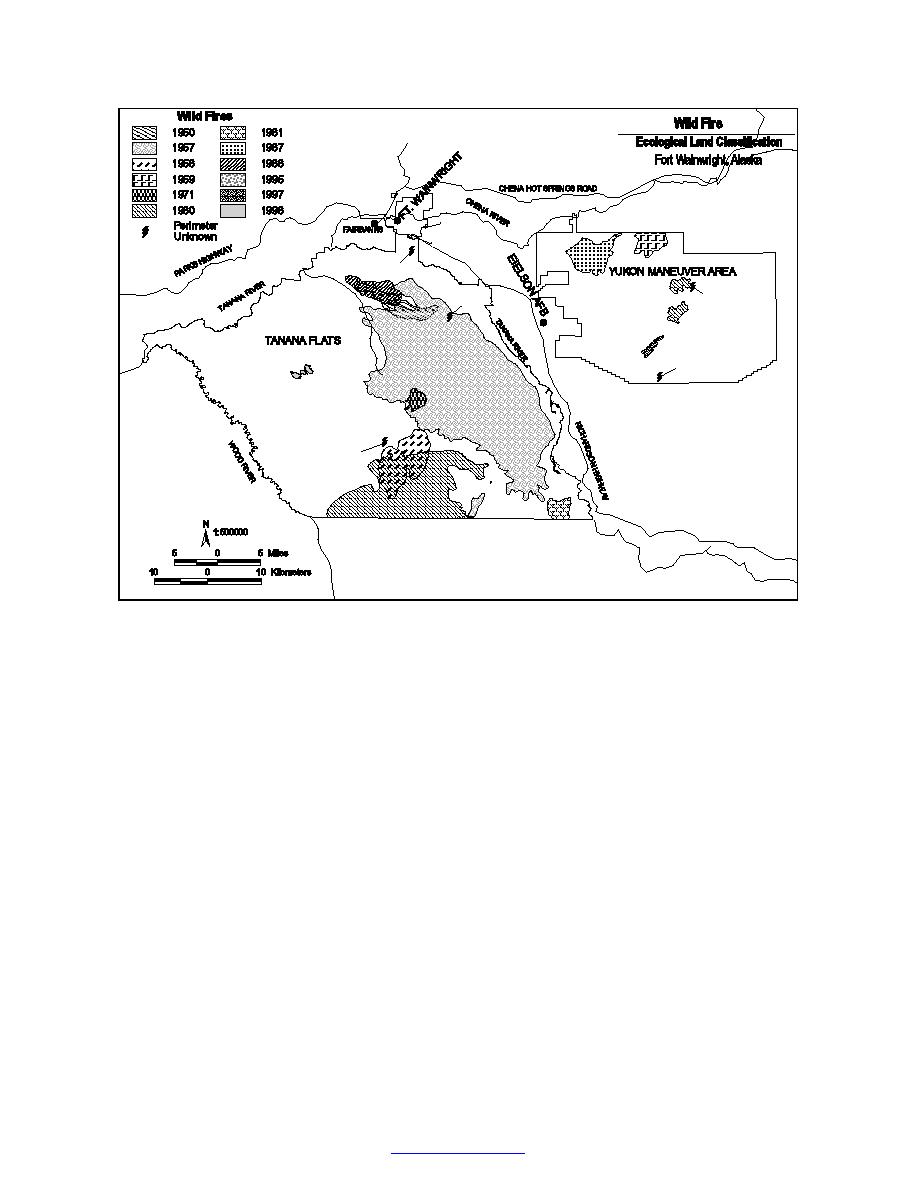
1950
1995
1957
1976
1974
1966
Historical wildland fire perimeters.
Contains fires greater than 400 ha
between 1950 and 1992, inclusive
and fires greater than 40 ha between
1993 and 1997. 1998 data unconfirmed.
1976
Reported start locations placed for fires
greater than 400 ha for which no
perimeter map has been located.
Data from: BLM Alaska Fire Service,
Fairbanks, Alaska, 1998.
Figure 32. Distribution and extent of forest fires within Ft. Wainwright, central Alaska, 1998.
30 yr). Midsuccessional ecotypes (Upland and
Fire
Lowland Broadleaf and Mixed Forest types) occupy
Fire is a frequent and widespread disturbance
~19% of the area. Late successional types (Upland
in interior Alaska that causes well-documented
and Lowland Needleleaf Forests) occupy ~27% of
stages of vegetation succession (Lutz 1956, Viereck
the area. The late successional types Lowland Tus-
1973, Van Cleve et al. 1983). In our study area, com-
sock Bog and Lowland Wet Scrub (not including
pilation of forest fire distribution through histori-
low scrub-post burn vegetation type), which have
cal reports and remote sensing by the Alaska Fire
little tree cover and poorly understood succes-
Service reveals that approximately 30% (110,108
sional development and fire history, occupied 8%
ha) of the study area has been burned since 1950,
of the area. Additionally, some of the thermokarst
although a substantial portion of this burned area
complexes include some burned areas.
(17,294 ha) has burned more than once (Fig. 32).
Effects of fire on ecosystem development depends
Despite the general nature of the wild fire data
on the nature of the ecosystem (i.e., species, life-
(some fires are not documented and some fire
history characteristics, soils), and the severity and
perimeters may enclose unburned areas) and the
frequency of the fire (Viereck 1973, Van Cleve et
difficulty in determining the successional status of
al. 1983). Severity of the fire will affect how much
some shrub communities, the fire data and veg-
of the organic matter on the forest floor is burned
etation data compare well. The abundance of early
and subsequent regeneration pathways. In gen-
successional ecotypes related to fire (Upland Moist
eral, forest stands are replaced by the same tree
Tall Scrub, Upland Moist Low Scrub, Closed and
species (Viereck 1973, Van Cleve et al. 1983). On
Open Low Scrub vegetation types within Lowland
moist upland sites (white spruce sites), Foote
Wet Low Scrub, and Lowland Gravelly Wet Low
(1983) identified six distinct successional stages: (1)
Scrub, see Table 9) indicates that ~5% of the entire
newly burned stage during 03 years, (2) herb-tree
study area has been burned recently (within about
60
Go to contents page



 Previous Page
Previous Page
